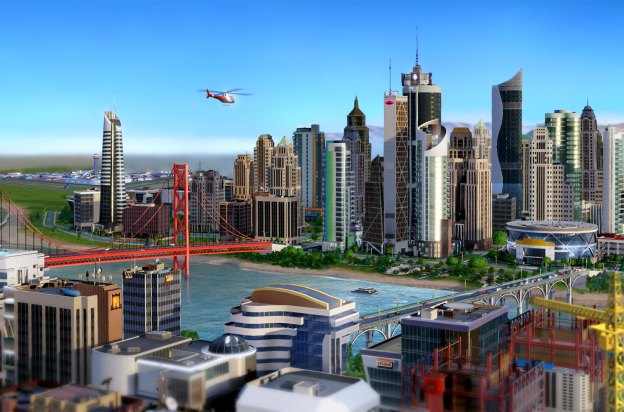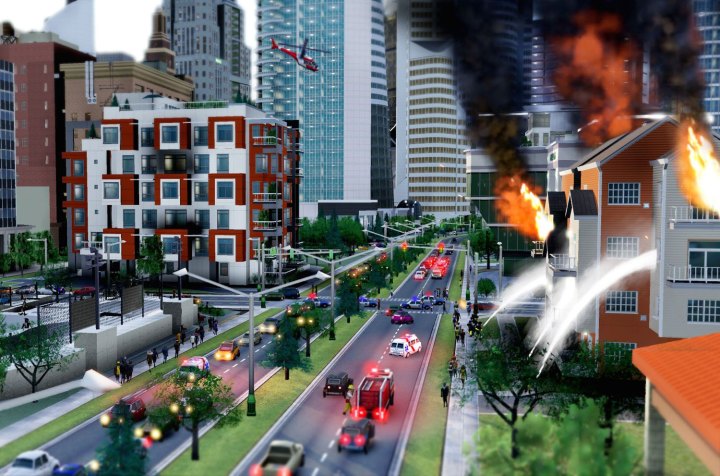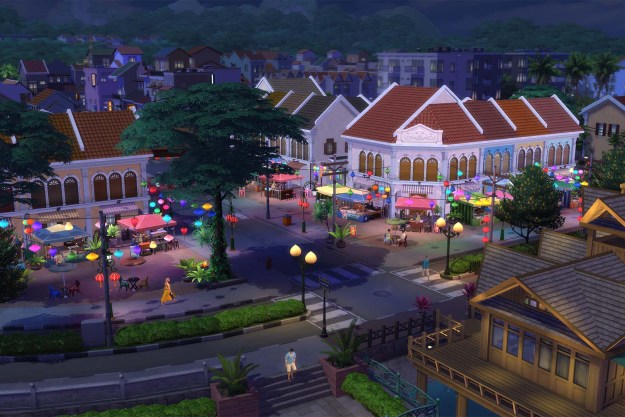
SimCity. There’s something powerful in Maxis’ decision to re-purpose the name of the inaugural game in its classic series for the freshly released reboot. It carries an implied declaration: this is the one, true SimCity. Whether or not you agree with that sentiment, it’s impossible to argue the basic fact that this is very much not SimCity as you remember it.
Laying down roads, zoning neighborhoods, and providing basic services are still tied to the fundamental A-to-B progression of play, but a newly online-connected focus is the beating heart of this revised city sim. Your creations no longer float in the ether of discrete saved games; they now exist in a region, one populated by other cities that are, in an ideal scenario, overseen by other players. You’re building on your own plot of land, but that construct exists in the context of a much larger, interconnected world. That’s the goal anyway. Does it come together as Maxis envisioned it? Read on.
The 800-pound Gorilla
To say that SimCity had a rocky launch is a gross understatement. The game unlocked for play on Origin at 12:01am ET on Tuesday, March 5, 2013. Things seemed fine to those who jumped in during those first hours, but the Internet connection-required servers that SimCity‘s regions live on, were a flaming wreck by Tuesday morning. It wasn’t until late Thursday that getting into the game smoothed out to the point that playing for an extended period was even possible, with stability only improving as the launch weekend descended.
In short, mistakes were made at Electronic Arts and Maxis, and launch day buyers paid the price. The standard “there were more players than we anticipated” line holds less and less water these days, especially when it’s coming from a publisher like EA that has had problems like this in the past. Whether or not you think that the make-good offer of one free Origin game to those who activate their SimCity copies by March 18 is worthwhile is besides the point. This review is about the game itself, not technical issues that led to a stumbling release. Still, it’s impossible to discuss SimCity in the context of a review and not mention what happened during launch week.

There is, however, a silver lining to the SimCity server fails. I managed to put in a good 10 hours on a couple of different cities during launch week, and then 10 or more from Friday onward as more people started to get back online. Looking at the early play and comparing it with what I experienced this weekend, I can see why the online component is so necessary. I’m not here to argue the relative merits of including an offline mode, but I will say that I got a lot less from this new SimCity playing all by my lonesome in a multi-city region. The game moves more slowly and it’s just plain not as fun. We’ll get to all of this soon enough.
The point here is simple: SimCity‘s launch sucked, but technical woes involving an overloaded network infrastructure fall outside the scope of a review. The way the servers are arranged is a consideration from the perspective of how some questionable choices impact your play – and you’ll read about that below – but this work of critical analysis focuses on the game in its current form and not the temporary situation that existed last week.
Now that that’s out of the way, let’s consider Maxis’ dramatic re-envisioning of its classic game.
SimsCity
To best understand this SimCity revision, it’s important to grasp the fundamental change implemented by Maxis’ new GlassBox simulation engine. In previous games, numbers crunched behind the scenes determined the course that your creation was headed in. It’s more transparent here, with everything unfolding in plain sight. Your city is populated by any number of sims, each of whom has his or her own home, job, daily routine, hopes, dreams, and so on. The aggregated public sentiment of these individuals taken together is what drives success and failure in this new SimCity, and you can see it all happening right in front of you on the very streets that you lay down.

In previous efforts, for example, the game might notice that you have more buildings than your power supply can realistically service. Brownouts cause unhappiness, and your city suffers. It’s a clinical take on an organic problem. The end result is still the same in the newly re-tooled SimCity: skimp on power, or any other service, and your constituents will be unhappy. The difference is in the details. Rather than invisible, behind-the-scenes calculation, you can see individual sims becoming more and more disgruntled thanks to easy-to-read visual indicators, such as colored red/green arrows and smiley/frowny faces.
So the basic idea that an unreliable power grid creates unhappiness remains, but the fact that it all plays out right in front of you on the micro level has a huge impact on the sense of investment you have in what you are creating. You’re no longer juggling a series of meters, you’re addressing the whims of the people. Of your people. The sims of your city really matter now, thanks to GlassBox, and you end up feeling much more like the mayor you’re supposed to be as a result.
Make no mistake: this isn’t The Sims. You can’t drill all the way down to the micro level and start naming all of your city’s citizens or managing their day-to-day affairs. The sims who move in are the lifeblood of your city, but they act as they please with a mind toward creating the best possible life for themselves. The goal on your end is to provide them with the means for achieving that, both within the somewhat limited context of your singular city plot and within the larger region that houses different specialized cities.
We Are The World
The most game-changing element in this new SimCity is the idea of regions. You’re building on much smaller plots of land than you may be used to from past games, but every chunk of build-friendly in SimCity is part of a larger region that houses anywhere from 2-16 plots. These discrete locations are all connected to one another by a highway, railroad network, and/or waterways. It’s up to you to build train stations and ferry terminals, but the infrastructure is all in place on a region-wide scale when you begin.

This isn’t just a cosmetic feature. Sims in one city will travel to the others for various purposes. If you build an industry-clogged city in one part of a region and then a shopping destination/gambling mecca/tourist trap in another, sims will use whatever form of transportation that you’ve provided to address their particular needs. They’ll travel from the former to the latter in search of leisure time entertainment, and from the latter to the form in search of work. The complementary setup benefits both cities, to the point that city growth in this new SimCity is eventually stifled due to the limited real estate available in each plot.
This is where city specializations come in. There’s not nearly enough space in one plot of land to build in every bit of infrastructure required to make your own, private megalopolis. Once your growth in a given city plateaus, finding the right specialty is effectively a requirement.
You can focus in any number of directions, such as trade, tourism, mining/industry, and gambling. This is usually dictated by the direction your city has grown in and the resources that you have on hand. A preview pop-up offers a sense of the what types and how much of each resource you’ll have to work with when you first choose a plot of land. You can also apply a variety of map overlays that bring up heat maps showing how things like ore, oil, water, and wind are dispersed in a given area. This allows you to plan in advance for future expansion toward one specialization or another.
The result is a much stronger sense of organic growth, with your city evolving naturally in one direction or another. It’s a dramatic swing away from the single player-focused, all-in-one city design of the previous games, which is both a good and a bad thing. You have this sense now of building into your own small corner of a larger world, but the reduced amount of land you have to work with for a given city eventually leads to a choice that isn’t really a choice at all: limit your ability to grow past a certain point or pick a specialization and run with it.
To be fair, the new approach is an improvement on the old one. Specializations may be an unspoken requirement, but the experience is stronger with them than without. The assortment of Maxis-created regions available at launch is a decent start, but we’ll hopefully see improvements down the road that include larger city plots and a more varied assortment of environments.
An Eye For UI

Then there are the map overlays, which are as pleasing to look at as they are to make use of. Name an aspect of your city’s infrastructure, and there’s probably an overlay for it. You can look at everything from power and water distribution to wind direction and speed to the general state of happiness in your city. A master list can be called up at anytime via an icon in the bottom right corner of the screen, but a list of related map overlay options appears whenever you select one build option or another. Choose zoning, for example, and a pop-up window offers quick access to expanded views on building density, population dispersal, and the like.
The interface isn’t perfect, however. While most of the icons are easy enough to identify, not all of them are clearly marked. Getting the hang of sharing resources within a region is especially unclear (though easy enough to deal with once you grasp how it works). Tutorials pop up at regular intervals offering a rundown of one concept or another as the need arises, but this can sometimes happen too late – especially in a game that rewards advance planning as much as SimCity does. It would have been nice to see some kind of centralized help resource, a la Civilization‘s Civilopedia.
Server Service
Implementing an always-online requirement proved to be one of the most controversial and unpopular choices that Maxis made with SimCity, which has traditionally been a single player-driven experience. The re-tooled approach definitely takes a hit when you choose to go it alone. The size of the city plots is restrictive, sure, but the process of building out a region and establishing cities that complement one another is slow and tedious. You’re constantly putting hours into one creation, then stopping and starting over with another, only to go back to the first creation to further tweak it. And then back to the second, and maybe to a third, and so forth.
With other humans moving in and populating a given region, the process feels much more organic. City Hall modules that unlock additional build options operate on a region-wide scale, so, for example, one city’s department of transportation brings benefits to all. You can zoom in for a close-up look at any other city in a region to get a sense of what’s there and what it’s lacking. You take all of this into account as you start building your own creation and evolve into a functioning resident of a larger community.
The decision to foster more of a community spirit by way of an always-online requirement remains questionable, but it’s hard to deny the facts. There is certainly some appeal to solo play within a region, especially in smaller locations with fewer plots of land, but this new take on SimCity just isn’t as much fun without the multiplayer element. Playing alone is slower and more tedious. It’s an option, and one that many will no doubt jump on, but it’s also the lesser option by comparison. An offline play component would have been undeniably nice, but this is a new SimCity for a new era in gaming.
That said, the server setup could use some major tweaks. Forget the launch week issues that crippled the game completely; as unpleasant as it was, it’s also an occupational hazard with online-only games. Like it or not, SimCity is one of those now. It’s much harder to forgive the questionable decision to lock your creations to a single server.
Players can jump freely between the various servers that are available, but progress in one region on one server doesn’t carry over to another. There is almost certainly a technical explanation for why things need to be this way, but that doesn’t really matter to the player. As we saw last week, losing access to the server you’ve been playing on means losing access to whatever creation you’ve been putting time into until that server is restored. This is a problem, to say the least.

There’s also an annoying issue when it comes to jumping from a server you’ve been playing on to a server that you haven’t visited previously in which the game forces you back into its tutorial city. While you do have the option of quitting back to the main menu if you don’t want to run through the whole thing again, it’s a needless waste of the player’s time just to wait for the thing to load before you can quit out. Why not just make the entire tutorial an optional component that is always accessible from the main menu?
Conclusion
This is not SimCity as you remember it. There are many familiar bits and pieces scattered throughout, but the overall experience has evolved. Online play is now fundamental to that, with a fresh, new focus on region-building bringing added depth to the more micro-level concerns of city-building. Maxis made some questionable choices on the design side, but the overall effort and scale of what’s been achieved here is largely outstanding. It may come at a considerable cost, but SimCity is a better game now than it has ever been before.
Score: 8.5 out of 10
(SimCity was reviewed on an Alienware X51 equipped with a 3.0 GHz Core i5-2320 CPU and an NVIDIA GeForce GTX 555 GPU using a copy of the game that was provided by the publisher.)
Editors' Recommendations
- The Sims 5: release date speculation, trailers, gameplay, and more
- Heroes of Middle-Earth isn’t afraid to play with Lord of the Rings canon
- Apex Legends Mobile isn’t a great fit for small screens
- FIFA 20 is out now, but Career Mode isn’t going over well with players














